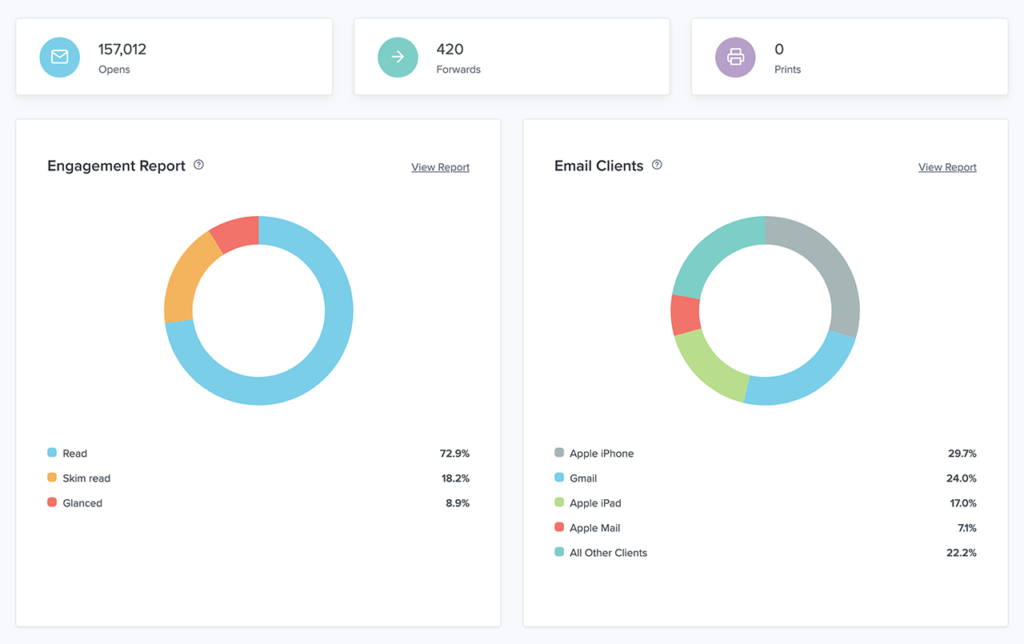Apple’s new Mail Privacy Protection features will have widespread implications for email marketers, causing marketers to implement multiple strategies to adapt. Why? It’ll affect everything from email analytics and deliverability to email strategy and design in a significant way. That’s because these changes, which debut this fall, will prevent email senders from seeing Apple Mail users’ open behavior, IP address, location, and device information.
In particular, the lack of visibility around opens will be a challenge.
Apple will pre-fetch every email’s content at the time of delivery. That will not only make open times inaccurate, but will make it appear that nearly 100% of your emails that are received by subscribers who use Apple email clients are opened, whether they actually are or not.
It’s no small problem, since about half of all email opens occur on Apple Mail currently, according to Litmus data. The false opens generated by Apple will dramatically inflate overall email opens, which marketers have traditionally used as a signal of engagement for a variety of purposes.
However, there’s one solution that can help address several of the challenges caused by Apple’s new privacy protections. That is to segment out Apple Mail users. How can you do that? By using device identification. Let me explain…
How ‘real opens’ can be used to help you
During his presentation at the Apple Worldwide Developers Conference, Garrett Reid, Privacy Engineering at Apple, said that under the new privacy policy, the type of device reading the email won’t be revealed.
It’s currently unclear exactly how Apple will report device information, but it’s highly likely that marketers will at least be able to identify and create a new segment of unknown devices using tools like Litmus Email Analytics. Or marketers can come at it from the other direction, creating a segment of subscribers who are known to use non-Apple email clients.
However you do it, the goal is to create an audience of subscribers whose opens are real—that is, free of inflation. Yes, it’s true that opens are an imperfect metric that are distorted by image blocking, caching, and other factors, but they are consistent enough to be a highly useful signal of engagement, especially since open signals are up to 10 times more prevalent than click signals. And ultimately, a real open is infinitely more useful than a false open.
 |
How many of your subscribers use Apple Mail? See how much of an impact Apple’s Mail Privacy Protection could have on your email marketing efforts so you can prepare your program (or not). |
Let’s discuss all the ways that a segment of real openers could be used.
A stand-in for overall engagement
For many brands, opens are a poor performance metric. However, if you aren’t focused on conversions and selling directly, opens are indeed a key performance indicator. These brands typically include media companies, manufacturers, and B2B service providers, among others.
For these businesses, opens aren’t a vanity metric. They’re a key way to measure email marketing success. So, having a segment of real openers gives you a good estimate on your open rate across all of your subscribers, including Apple Mail users.
A substitute for email advertising impressions
Opens are a particularly critical performance metric for those of you who sell or place advertisements in your emails, like some media companies do. Opens tell you approximately how many ad impressions an email generated.
In aggregate, that is used to set ad rates and tell advertisers what kind of audience reach they can expect. So, having a reliable proxy for email opens will be essential for brands that do this.
A proxy for mailbox provider engagement levels
While open rates aren’t a good performance metric for most brands, they’re an essential email channel health metric for every brand. That’s because over the past decade, email engagement has become a massive component of spam filtering algorithms.
Mailbox providers track many engagement indicators, most of which are completely invisible to marketers, such as favoriting an email or saving it in a folder. Among the indicators that you can actually see, opens are the most critical because they’re the most frequent.
Unless Google, Microsoft, Yahoo, and other mailbox providers change their filtering algorithms dramatically in response to Apple’s new privacy features, you’ll need to continue to pay attention to open rates among your subscribers using each mailbox provider. For instance, Oracle Marketing Consulting’s Email Deliverability Services team becomes concerned when one of our client’s open rates dip below 10% at an individual mailbox provider, as that tends to lead to junking and blocking.
Warming up new IP addresses
When you change the IP address from which you send your marketing emails, you need to gradually build up a sender reputation for that IP address to avoid blocking and junking by mailbox providers. The best way to do that is to start off small and gradually send more email each day from that IP address over a period of weeks.
However, the critical element here is that you only want to send to your most engaged subscribers during this warmup period. How do you identify your most engaged subscribers? By tracking real openers.
Calculating an accurate click-to-open rate
Opens are also a key part of click-to-open rates (CTOR). That’s a measure of how efficiently an email’s message and design convert openers into clickers, as well as how aligned a subject line is with the body content of the email.
Having an audience of real openers allows you to recognize when you have a disconnect and may need to make some changes or, better yet, do some A/B testing. On that note…
Creating a test audience
If your company is going to do any A/B testing that involves open rates, open times, or CTOR, then having an audience of real openers is vital. Allowing false opens to skew your testing results is yet another item on a long list of A/B testing pitfalls to avoid.
In addition to needing this audience to test click-to-open efficiency of different email messaging or designs, you might also need it to inform subject line optimization and establish a default send time for send time optimization (STO). Or simply to set an overall send time, if you don’t use STO.
That said, Apple’s Mail Privacy Protection is likely to drive clicks to play a much bigger role in both subject line optimization and STO, with most marketers benefiting significantly from the incorporation of that less common, but higher-intent signal.
More than a vanity metric
Hopefully, Apple’s Mail Privacy Protection features will cause you to think critically about how you’re using open-based metrics. But to call opens purely a vanity metric is to misunderstand the important role they play in measuring performance, maintaining good deliverability, and crafting efficient email experiences. Identifying and creating an audience segment of real openers now will allow you to continue to use opens to create better emails.
 |
Get quick, easy-to-use insights with Litmus Look beyond opens and clicks. Get the exact data you need, from read times to geolocation, with at-a-glance email analytics. And that’s just one way Litmus empowers you to create better emails. |
Chad S. White is the Head of Research at Oracle Marketing Consulting. He’s also the author of “Email Marketing Rules” and more than 3,000 articles and posts about email marketing. Featured in The New York Times, The Wall Street Journal, and more than 100 other publications, Chad was named the Email Experience Council’s 2018 Email Marketer Thought Leader of the Year. Find him on Twitter and LinkedIn.
The post Identifying ‘Real Opens’ Is Key to Adapting to Apple’s Mail Privacy Protection appeared first on Litmus.
![]()

